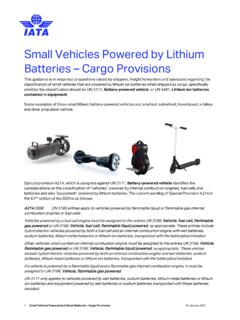Transcription of ELECTRIC VEHICLES AND THEIR IMPACT ON OIL DEMAND: …
1 ELECTRIC VEHICLES AND THEIR IMPACT . ON OIL DEMAND: WHY FORECASTS DIFFER. BY MARIANNE KAH. JULY 2018. Introduction While the passenger vehicle sector represents only about one-quarter of the oil demand barrel, the sector receives a significant amount of attention from some governments and the media. This is due largely to the belief that a rapid transition from conventional oil-powered cars to ELECTRIC VEHICLES (EVs) is both possible and necessary to reduce greenhouse gas emissions and improve urban air quality. Numerous studies analyzing the IMPACT of EVs on oil demand have been published.
2 To determine whether the enthusiasm around the potential for EVs to reduce fossil fuel consumption is warranted, the author reviewed several of these studies and found that it was difficult to derive insight from comparing these published forecasts, because they were not calculated on the same basis and they failed to provide some key underlying assumptions. To bridge that gap, the author conducted a survey of 15 of these forecasters representing governments, think tanks, consultants, investment banks, and oil companies to obtain comparable data along with THEIR underlying assumptions, with the agreement that the sources of the data would not be disclosed.
3 Summary The review showed that none of the passenger vehicle forecasts projected much oil demand growth over the next 25 years. This was an area where there was clear agreement among forecasts. In many cases, demand remained flat after peaking. A few forecasts, particularly two-degree carbon scenarios, showed a considerable decline in demand in this sector by 2040. However, even in these cases, no decline in demand is projected before 2020, and there isn't much decline before 2030. It should also be noted that any decline in oil demand from the passenger vehicle sector could be offset by demand growth in the petrochemical, aviation, or freight transport sectors, which have fewer and more costly substitutes for oil.
4 The pace of demand growth matters. If the world doesn't move off oil at a rapid clip, it is important that policy makers recognize the need for investment in new oil supplies to prevent supply shortages and accompanying oil price spikes. The review also showed that forecasters had widely disparate views of the underlying drivers of demand. Figure 1 illustrates the wide range around the mean of the highest and lowest | JULY 2018 | 1. ELECTRIC VEHICLES AND THEIR IMPACT ON OIL DEMAND: WHY FORECASTS DIFFER. forecasts of the underlying components of demand.
5 The forecasts on the two-degree carbon trajectory generally assumed significantly lower population growth and higher ELECTRIC vehicle sales and usage than the other forecasts. In fact, it is possible that these carbon scenarios reflect what needs to happen to get on the two-degree trajectory as opposed to the forecasters' view of what is likely to happen. Other forecasts had significantly lower EV. penetration relative to the mean, reflecting the view that there will be only incremental and relatively slow change in the passenger vehicle sector rather than disruptive change.
6 Figure 1. Wide differences in forecasters' views of key demand drivers Percent Increase/(Decrease) of Highest and Lowest Forecasts Around the Mean of All Forecasts Source: CGEP Survey & Analysis Demographic changes and economic growth are large drivers of global oil demand, and even without EV penetration, THEIR slowing growth rates will continuously weaken the rate of oil demand growth over the long run. Rising income and urbanization in developing countries are counterbalancing forces. Two-degree carbon forecasts tend to assume lower population growth, which exacerbates the expected decline in passenger vehicle sector oil demand.
7 There is no consensus on the IMPACT of a two-degree carbon scenario on economic growth. A variety of economic growth assumptions are used, which have the effect of either exacerbating (in the case of low economic growth) or minimizing (in the case of high economic growth) the decline in oil demand. Technology change and government policies to encourage EV adoption are the most uncertain factors affecting the trend in passenger vehicle sector oil demand. For example, if battery pack costs are reduced to $100/kWh sooner than the mid-2020s, it would encourage 2 | | JULY 2018.
8 ELECTRIC VEHICLES AND THEIR IMPACT ON OIL DEMAND: WHY FORECASTS DIFFER. a more aggressive shift to EVs. Similarly, government policies incentivizing or mandating EVs or other alternatives will reduce oil demand more quickly. However, the impacts on oil demand of automation and the development of mobility services are less clear. Fleets of autonomous VEHICLES available on demand could reduce the cost of driving and make it more convenient, thereby increasing travel and energy demand. But autonomous vehicle fleets might be ELECTRIC because EVs have lower operating costs than conventional VEHICLES and city governments may direct them to be ELECTRIC for clean air purposes.
9 Additional research is needed to understand the oil demand impacts of autonomous VEHICLES and new models of mobility. Rationale for Studying the Passenger vehicle Sector As shown in figure 2, passenger VEHICLES represented only about one-quarter of global oil demand in 2016. This equates to about 25 million barrels per day out of an estimated demand of 94 million barrels per day. Figure 2. Global oil demand by sector (% share, 2016). Basis 94 million b/d Source: International Energy Agency 2017 World Energy Outlook However, passenger VEHICLES receive an inordinate proportion of government and media attention because the sector is highly visible (many people purchase cars) and some governments believe that a rapid transition from conventional to ELECTRIC cars is now possible and will help them reduce greenhouse gas and other emissions.
10 In fact, a number of governments around the world have recently mandated the phaseout of fossil fuel powered cars beyond 2030 or 2040. Figure 2 serves as a good reminder that many other sectors besides passenger VEHICLES use | JULY 2018 | 3. ELECTRIC VEHICLES AND THEIR IMPACT ON OIL DEMAND: WHY FORECASTS DIFFER. oil. Even if passenger vehicle sector oil demand use were to decline, total oil demand wouldn't necessarily decline, if there were growth in oil demand for petrochemical feedstock, aviation, and freight movement. Finding substitutes for these biggest oil demand growth sectors is difficult and costly.










